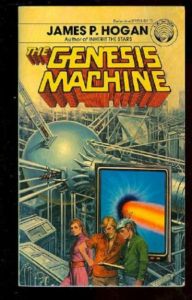Brad Clifford's theory was just applied mathematics -- but its implications were too hot for the frozen minds of his superiors. So they buried it -- and him -- under wraps of secrecy.
Then Aubrey Philipsz, iconoclast and fellow genius, appeared on the scene to build the Genesis Machine Clifford's theory made possible.
Suddenly, all weapons seemed useless before the previously unimagined power of the Genesis Machine. It could wreck a world or save it -- and the men who ruled that world on a path of disaster now fought to gain control of this new force.
But Clifford and Philipsz had another goal, another dream. They were reaching for the stars!
"In the grand tradition of the classic super-science stories, but with more exciting science and with better writing, too. What more can anyone want?" -- Isaac Asimov
| Cover Price |
$1.75 |
| No. of Pages |
288 |
| Height x Width |
7.2
x
4.2
inch |
| Original Publication Year |
1978 |
|
| Read It |
Yes (12/25/2011) |
| Owner |
John |
| Links |
Amazon
|
|
The Genesis Machine (1978) 299 pages by James P. Hogan.
Bradley Clifford is a physicist who has come up with a theory of the fundamental nature of matter and energy involving extra dimensions which he terms k-space. He is trying to publish a paper, but he works at ACRE, which is run by the military, and they don't want any knowledge that could be used against them out there for the enemy to see. When his attempt is shot down he sends his paper to Zimmerman at a station on Luna, who is one of the few scientists not under military direction.
A few weeks later Aubrey Philipsz from Berkeley tracks him down and asks if he's the guy who came up with the k-space theory. It turns out that the upper management at ACRE have a problem with Clifford and are trying to keep him out of the loop.
This world of 2005 is on a downward spiral of conflicts and arms build up, with the balance of power shifting from West to East. This is why the army is trying to coerce scientists into making more weapons.
The first half of the book is mostly Clifford explaining k-space theory. Then there is a chapter thrown in about the wars and skirmishes going on around the world. A little after that there is a chapter thrown in about the BIAC, a computer that gets its input via a helmet that the user wheres so the BIAC can read the thoughts of the user. That seems like as big a stretch as the k-space theory and it's dumped on the reader two thirds the way through the book.
That is all used to set up the climax. It all works out somehow -- based on the way the leaders in Hogan's year 2007 act and react. Maybe in 1978, that's the way we thought the leaders would act, i.e. being a little to free with the nukes and other warmongering activities.
If you enjoy discussion on relativity and beyond, the first half of the book is fantastic, and in the second half the story is, let's say, satisfying. I think the segues could be better. Still the story didn't bog down, even with a hundred pages of talk of k-space, it was enjoyable. I'd recommend Thrice upon a Time over this one.
